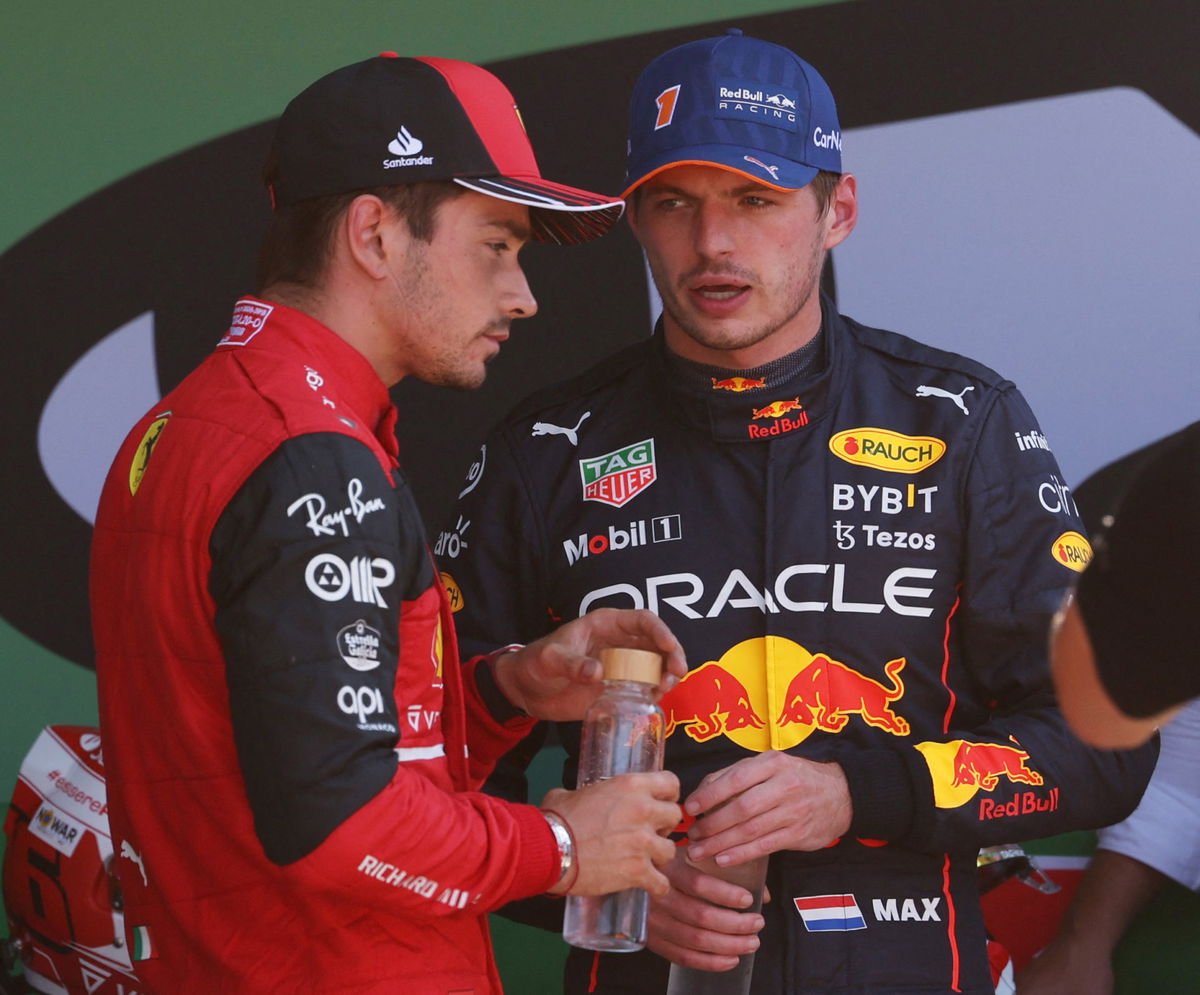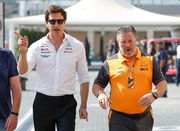
Reuters
Formula One F1 – Dutch Grand Prix – Circuit Zandvoort, Zandvoort, Netherlands – September 3, 2022 Red Bull’s Max Verstappen and Ferrari’s Charles Leclerc after qualifying REUTERS/Piroschka Van De Wouw

Reuters
Formula One F1 – Dutch Grand Prix – Circuit Zandvoort, Zandvoort, Netherlands – September 3, 2022 Red Bull’s Max Verstappen and Ferrari’s Charles Leclerc after qualifying REUTERS/Piroschka Van De Wouw
In the world of Formula 1, where split-second decisions can decide the outcome of a race, the stakes are high, and the rules are strict. Every move made on the track is under scrutiny, and when drivers fail to follow the established rules, the FIA (Fédération Internationale de l’Automobile) doesn’t hesitate to dish out penalties.
Watch What’s Trending Now!
However, the system of penalty in F1 is so nuanced and complex that it can sometimes feel daunting to keep track of why and how drivers get penalized. In this article, we’ll dive deep into the world of penalties, how they are applied and why would FIA need to have such a complex penalty system in the first place.
ADVERTISEMENT
Why does FIA dish out penalties in Formula 1?
Formula 1 is the pinnacle of motorsport. It is as dangerous as it is fast and therefore, adherence to rules is paramount. The FIA stewards have the authority to hand out penalties that can influence not just a single race but the entire trajectory of a driver’s season. These penalties aren’t merely punitive measures though. They’re strategic checks put in place against actions, either by the driver or by the team, that could compromise fair play.
The consequences of penalties extend beyond the immediate race, with the prospect of accumulating penalty points on a driver’s FIA Super License that renews before the start of each season. This 12-month rolling period adds gravity to the penalties, potentially leading to a racing ban if a certain threshold is crossed. It’s a fine balance between maintaining order on the track and allowing for the high-speed competition that fans crave.
Top Stories
Language Barrier Didn’t Hold Back Lando Norris to “Hook Up” With OnlyFans Model: “We Talked by Mime”

Zak Brown & McLaren Possibly in Deep Trouble as Mercedes Cuts Engine Supply for F1 2026

Who Are Lando Norris’s Parents? Meet Adam Norris and Cisca Wauman

Adrian Newey’s Motorsport Masterpiece: RB17 vs Aston Martin Valkyrie, Which One Is Better?

3 Years After His Death, Niki Lauda’s Wife Brutally Disrespects Him to Initiate $32,000,000 Battle Against Own Children

The penalties serve as a tool to enforce compliance, discouraging actions such as blocking, exceeding track limits, ignoring flags, or engaging in unsafe driving practices. The rules, outlined in the FIA Formula One Sporting Regulations, categorize penalties into five escalating levels:
ADVERTISEMENT
- Reprimand or Warning
- Time Penalty
- Drop in Grid Places
- Disqualification from the Event, and
- Suspension from Further Races
ADVERTISEMENT
What’s the decision-making process behind F1 penalties?
Penalties in Formula 1 are not arbitrary decisions but the result of a careful process that combines investigating procedures, on-track surveillance, and swift decision-making mechanisms. The integrity of the sport is safeguarded through scrutineering, where specific car parts are monitored for compliance with regulations. Any changes beyond permitted limits trigger penalties that are fit for the level of infringement.
On the track, the race director and stewards, who sit in the race control room, maintain surveillance. They analyze unfolding action through several screens displaying various camera angles and official data feeds. The goal is to identify any incidents or maneuvers that breach established rules and regulations.
When a potential infringement is detected, it quickly moves to the race director and stewards for review. Implicated teams are immediately notified, initiating a process of evaluation. Stewards get together to discuss the situation, looking at the evidence and considering perspectives. The outcome is a decision reached as quickly as possible. Crucially, the drivers face penalties only when considered wholly or predominantly responsible for the observed incident. This ensures that the drivers are held accountable for their actions while considering the nuanced nature of each situation.
ADVERTISEMENT
What is a Reprimand or a Warning?
At the most basic level of penalties is the “Reprimand” or “Warning,” a stern caution issued by FIA stewards. Drivers are allowed five reprimands in a season. Exceeding this limit triggers an official warning, leading to a ten-place grid penalty. This progression emphasizes the gravity of repeated infractions, serving as a clear check against minor offenses.
⚪ NEW IG POST | For the 2022 season, the FIA and Formula 1 have revised the rules for reprimand's. Drivers will face a 10-place grid penalty after five reprimand's and not after three. #F1
➡️ https://t.co/oX15Tda6go pic.twitter.com/fwnxC3PPU0
— Ahmet Cir (@AhmetCirF1) February 2, 2022
ADVERTISEMENT
Actions meriting a reprimand usually involve minor incidents, such as cutting corners or forcing another driver off the track. Stewards communicate these rules explicitly to drivers before each session, tailoring instructions to the specific characteristics of the track. The system maintains clarity, avoiding ambiguity and ensuring drivers are well aware of the consequences of their actions.
Time Penalties in Formula 1: Racing Against the Clock
The second tier in the hierarchy of Formula 1 penalties is the “Time Penalty,” a disciplinary measure dished out by stewards for offenses ranging from mild to severe. This category has four distinct types of time penalties, each tailored to the level of the transgression.
ADVERTISEMENT
Five-Second time penalty
This penalty mandates a five-second stoppage for a driver at their subsequent pit stop. The condition here is that mechanics are prohibited from touching the car during the initial five seconds before servicing the car. If the mechanics are found to have touched the car during the first 5 seconds, the stewards can investigate further and give an even more severe penalty or another 5-second time penalty.
ADVERTISEMENT
Ten-Second time penalty
This is a more substantial penalty, this mandates a ten-second stoppage at the driver’s next pit stop. Similar to the five-second penalty, mechanics are restricted during the first ten seconds before they can service the car or they can attract more penalties.
Drive Through penalty
When slapped with a drive-through penalty, the driver must navigate the pit lane adhering to a designated pit lane speed limit, and exit without coming to a halt. There’s a two-lap window for the driver to enter the pit lane once the penalty has been handed down. Failure to comply within this timeframe leads to the driver being black-flagged (disqualified).
ADVERTISEMENT
Ten-Second Stop-Go penalty
This is the most severe of the 4 time penalties. It involves the driver entering the pit lane, coming to a complete stop at their pit box for ten seconds, and then exiting. Like the drive-through penalty, the driver has a two-lap window to fulfill this obligation, and mechanics are explicitly barred from touching the car throughout the penalty duration.
These time penalties cover a range of offenses, including but not limited to, starting prematurely, speeding in the pit lane, causing accidents, unfairly blocking other drivers, speeding behind the Safety Car or the Virtual Safety Car, or disregarding safety flags. The conditions attached to each penalty emphasize the strict nature of Formula One regulations, ensuring penalties are proportional to offenses and applied with precision.
Grid Place penalties: A game of limits and consequences
The “Grid Place Penalty,” is the third tier of F1 penalties that kicks in for pre-race technical infringements, especially related to the replacement of Power Unit (PU) components such as the Turbocharger, Internal Combustion Engine (ICE), Energy Store, Motor Generator Unit – Kinetic (MGU-K), Motor-Generator Unit – Heat (MGU-H), Control Electronics, and the Exhaust.
Each driver is allowed a fixed number of these components that they can use throughout the season. For example, a driver is allowed to use up to 3 Internal Combustion Engines in a season. Once the driver takes his 4th engine, he gets a 10-place grid penalty and starts the race 10 places below the qualifying position. The subsequent changing of such components results in a 5-place grid penalty.
How does the starting grid change if multiple drivers face grid penalties?
The starting grid formation involves a systematic approach, considering the order of offenses and prioritizing teams based on their timely communication with the technical infringement. Penalties are applied sequentially, aligning with the chronological order of offenses. Efficiency and communication play a pivotal role, as the team that promptly informs about the technical delegate gains preference. If multiple drivers have been relegated to the back of the grid, they start by their qualifying order.
With penalties applied, here's a re-vamped starting grid for Sunday's Grand Prix! 👀#CanadianGP #F1 pic.twitter.com/ssDg25XQDk
— Formula 1 (@F1) June 18, 2023
Disqualification: Understanding the black flag mystery
A “Disqualification” penalty is rare but it is a useful tool available to the Stewards and the Race Directors. Reserved for offenses beyond the norms of fair play and sportsmanship, disqualification is the ultimate consequence for any driver on a given race day. When a driver is disqualified, a black flag is waved with the driver’s number and it means they need to pit as soon as possible and retire the car.
Disqualification isn’t handed out lightly though. Persistent unsportsmanlike conduct, non-compliance with imposed penalties, or causing deliberate collisions—these are offenses that warrant the ominous black flag. Over the years, disqualifications have been rare but essential in maintaining the integrity of the sport.
The only thing bigger than a disqualification is if the FIA finds your actions worth suspending you, which is never a good thing for a driver as it can ruin his season completely.
Suspension: The Ultimate Punishment in F1
“Suspension” is a penalty that extends beyond a single race, reaching into subsequent events of the season. Reserved for offenses of grave severity or repeated instances of misconduct, suspension is the highest level of penalty in F1. It’s a ban from participation in one or multiple subsequent races, a measure that stewards deploy with great deliberation. It’s a decision that shows the commitment of F1 to uphold the highest standards of sportsmanship and fair play.
Stewards invoke suspension only for egregious offenses that compromise the integrity and safety of the sport. It could be unsportsmanlike behavior, repeated violations, or actions jeopardizing fellow competitors. Alternatively, suspension may also be triggered if a driver accumulates 12 penalty points on their FIA Super License over a designated period, usually a calendar year.
Super Licence Penalty Points: A System of Checks and Balances
The FIA Super License is more than just a credential that drivers need to take part in the Formula 1 season. It is also a tool to ensure safety and sportsmanship on the racetrack. The penalty point system attached to the Super License is a fine balancing act, aiming to maintain a standard of conduct among drivers.
The essence of the system lies in the accumulation of twelve penalty points within a calendar year. This triggers a series of consequences, with the most immediate being a one-race ban for the offending driver in an upcoming event. Following the suspension, the FIA wiped the twelve accumulated penalty points from the driver’s Super License. This reset of the penalty points emphasizes that the penalty point system is a measure of ongoing behavior rather than a permanent stain on a driver’s record.
Since the points accumulate over the season, the FIA resets the penalty point before the start of a new season. This ensures that drivers enter each new season with a fresh Super Licence without any overhanging penalty points.
Watch This Story | Fernando Alonso’s Confusing Penalty in Saudi Arabia Explained
If you have any specific questions related to F1 penalties or if we missed anything, feel free to ask us by leaving a comment below.
ADVERTISEMENT
ADVERTISEMENT
ADVERTISEMENT

